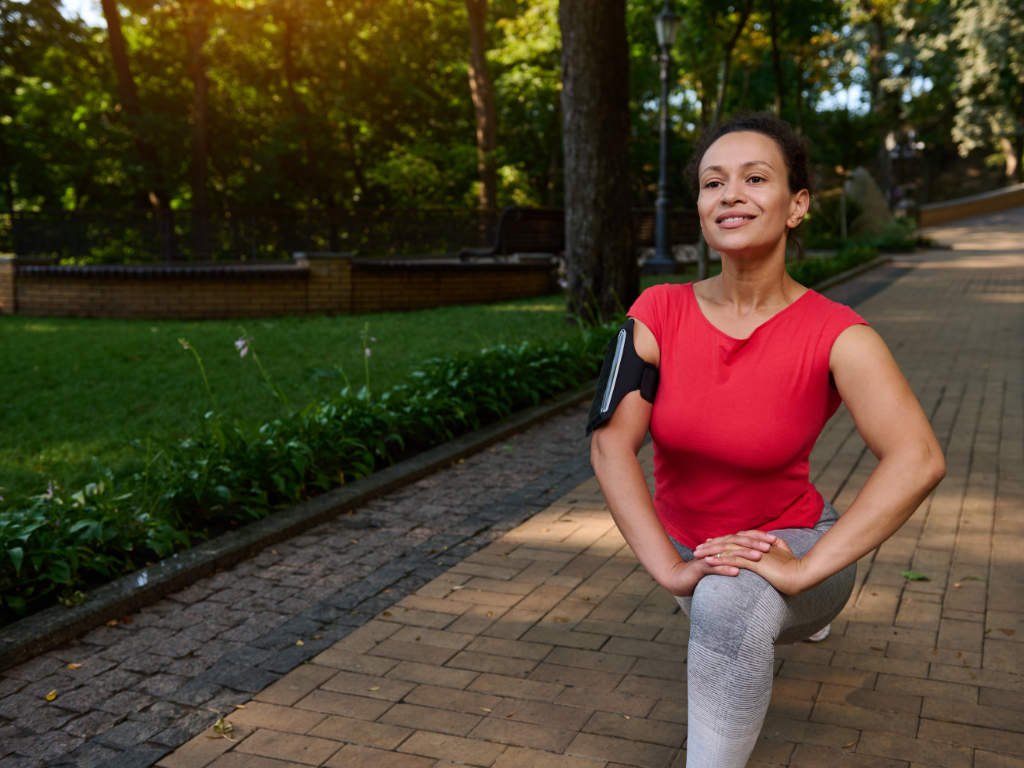Have you ever wondered why traditional fitness advice often feels like it’s designed for men, leaving women searching for routines that actually fit their unique needs? Exercises for women’s fitness aren’t just about shrinking into smaller sizes or achieving unrealistic beauty standards – they’re about building strength, confidence, and long-term health that supports you through every phase of life.
Let’s be honest: women face distinct health challenges that require thoughtful, targeted approaches to fitness. From hormonal fluctuations that affect energy levels to higher risks for osteoporosis and specific cardiovascular conditions, our bodies deserve workout routines that acknowledge these differences while celebrating what makes us strong.
What Makes Women’s Fitness Different?
Women’s bodies undergo incredible changes throughout their lives – from puberty through menstruation, pregnancy, and menopause. These transitions affect everything from bone density to muscle mass, making it crucial to approach fitness with strategies that work with your body, not against it.
Hormonal considerations play a massive role in how women respond to exercise. During certain phases of your menstrual cycle, you might feel energized and ready to tackle intense strength training, while other times call for gentler movement like yoga or walking. This isn’t weakness – it’s wisdom.
Research shows that women tend to recover faster from high-rep, moderate-intensity exercises compared to men, but we also face unique challenges. We’re more prone to ACL injuries, experience different fat distribution patterns, and often juggle multiple responsibilities that make consistent gym time challenging.
But here’s the empowering truth: women’s fitness routines can be incredibly effective when designed with these factors in mind. You don’t need to train like a man to get strong – you need to train like the amazing woman you are.
Why Women Need Specialized Exercise Approaches
Think about the last time you followed a “generic” workout plan. Did it account for your energy fluctuations during different times of the month? Did it consider that you might be managing work stress, family responsibilities, and personal goals simultaneously?
Women benefit from multifaceted fitness approaches that address:
- Cardiovascular health (we’re at higher risk for heart disease after menopause)
- Bone strength (osteoporosis affects women four times more than men)
- Muscle preservation (we naturally lose muscle mass faster as we age)
- Mental wellness (exercise significantly impacts mood and stress management)
- Functional strength (supporting daily activities and preventing injury)
The beauty of focusing on exercises for women’s fitness is that they’re designed to be sustainable, adaptable, and effective for real life – not just Instagram photos.
Essential Categories of Women’s Fitness Exercises
Cardiovascular Training: Your Heart’s Best Friend

Cardio isn’t just about burning calories (though it does that effectively). For women, regular cardiovascular exercise serves as powerful protection against heart disease, which kills more women than all forms of cancer combined.
Low-impact options work beautifully for women dealing with joint concerns or those just starting their fitness journey:
- Brisk walking (especially effective when you vary terrain and pace)
- Swimming (full-body workout that’s gentle on joints)
- Cycling (builds leg strength while protecting knees)
- Dancing (because who says exercise can’t be fun?)
Moderate to high-intensity cardio challenges your cardiovascular system and builds incredible endurance:
- Interval training on treadmills or bikes
- Group fitness classes like Zumba or kickboxing
- Hiking with elevation changes
- Jump rope (surprisingly effective and convenient)
The key is finding activities you genuinely enjoy. Research from Women’s Health Magazine confirms that women stick to exercise routines longer when they include elements of fun and social connection.
Strength Training: Breaking the “Bulky” Myth
Let’s address the elephant in the room: many women avoid strength training because they fear getting “bulky.” This misconception has kept countless women from experiencing the incredible benefits of building muscle.
Here’s the reality – women have significantly lower testosterone levels than men, making it extremely difficult to develop large muscle mass without very specific training and nutrition protocols. What you will develop is:
- Lean muscle definition that creates an athletic, toned appearance
- Increased metabolism (muscle tissue burns more calories at rest)
- Stronger bones (weight-bearing exercises build bone density)
- Better posture (strong back and core muscles support spinal alignment)
- Improved daily function (carrying groceries, playing with kids, maintaining independence as you age)
Bodyweight exercises provide an excellent starting point and can be done anywhere:
- Push-ups (modify on knees or against a wall as needed)
- Squats (perfect for building lower body strength and protecting knees)
- Lunges (improve balance while strengthening legs and glutes)
- Planks (core strength supports everything else you do)
Resistance training with weights amplifies these benefits:
- Dumbbell exercises for upper body development
- Kettlebell swings for explosive power and cardio benefits
- Resistance bands for targeted muscle activation
- Barbell movements for serious strength building
Research demonstrates that women who incorporate regular strength training see improvements in bone density, muscle tone, and metabolic health within just 8-12 weeks.
Flexibility and Mobility: The Foundation of Movement
Flexibility training often gets overlooked, but it’s absolutely crucial for women’s long-term health and fitness success. As we age, maintaining range of motion becomes increasingly important for preventing injury and maintaining independence.
Dynamic stretching prepares your body for activity:
- Leg swings before running
- Arm circles before upper body workouts
- Hip circles before squats or lunges
Static stretching helps with recovery and flexibility:
- Hold stretches for 20-30 seconds after workouts
- Focus on tight areas like hip flexors, hamstrings, and chest muscles
- Include spinal twists and shoulder stretches if you spend time at a desk
Yoga practices combine flexibility, strength, and mindfulness:
- Vinyasa flows for dynamic movement
- Restorative yoga for stress relief and recovery
- Power yoga for strength and flexibility combined
Many women find that incorporating flexibility work helps them feel more comfortable in their bodies and reduces the aches and pains associated with daily stress and aging.

Creating Your Personalized Women’s Fitness Routine
How Often Should You Exercise?
The sweet spot for most women involves 3-5 workout sessions per week, allowing for adequate recovery while maintaining consistency. This might look like:
- 3 days strength training (focusing on different muscle groups)
- 2-3 days cardio (varying intensity and duration)
- Daily movement (walking, stretching, or gentle yoga)
Remember, something is always better than nothing. Even 20-minute sessions can provide significant health benefits when done consistently.
Sample Weekly Schedule for Beginners
Monday: Full-body strength training (30 minutes)
Tuesday: Moderate cardio like brisk walking (25 minutes)
Wednesday: Yoga or stretching (20 minutes)
Thursday: Upper body strength focus (30 minutes)
Friday: Fun cardio like dancing or group class (30-45 minutes)
Saturday: Lower body strength training (30 minutes)
Sunday: Gentle movement or rest day
Progressing Safely and Effectively
Start where you are, not where you think you should be. If you can only manage 10-minute sessions initially, that’s perfect. Gradually increase duration and intensity as your fitness improves.
Listen to your body’s signals:
- Fatigue vs. exhaustion (fatigue is normal, exhaustion requires rest)
- Muscle soreness vs. pain (soreness indicates work, sharp pain indicates potential injury)
- Energy levels throughout your cycle (adjust intensity accordingly)
Muscle & Strength’s guidelines emphasize the importance of progressive overload – gradually increasing weight, reps, or duration to continue seeing improvements.
Overcoming Common Barriers Women Face
Time Constraints
Between work, family, and personal responsibilities, finding time for exercise feels impossible some days. Here’s how to work around it:
- Morning micro-workouts: 10-15 minutes before your day starts
- Lunch break walks: Fresh air and movement during work
- Family-friendly activities: Hiking, bike rides, or active playground time with kids
- Evening wind-down routines: Gentle yoga or stretching before bed
Gym Intimidation
Many women feel uncomfortable in gym environments, especially in weight rooms dominated by men. Consider these alternatives:
- Women-only gym hours or facilities
- Group fitness classes for community and support
- Home workout routines using minimal equipment
- Outdoor activities that feel less intimidating than indoor gyms
Our guide on home workout routines for body transformation provides excellent options for building strength and endurance from the comfort of your own space.
Budget Concerns
Fitness doesn’t require expensive gym memberships or equipment:
- Free outdoor activities: Walking, running, hiking, playground workouts
- Bodyweight exercises: No equipment needed for effective strength training
- YouTube fitness channels: Free guided workouts for every fitness level
- Community resources: Many parks and recreation departments offer low-cost classes
Nutrition Support for Women’s Fitness Goals

Exercise and nutrition work synergistically to support women’s health goals. While this article focuses on movement, it’s worth noting that proper fueling amplifies exercise benefits.
Key considerations for women include:
- Adequate protein intake to support muscle building and recovery
- Iron-rich foods to prevent deficiency common in menstruating women
- Calcium and vitamin D for bone health support
- Hydration that accounts for hormonal fluctuations
For comprehensive nutrition guidance, check out our ultimate balanced diet guidelines and sustainable weight loss secrets.
Managing Hormonal Fluctuations Through Exercise
Understanding how your menstrual cycle affects exercise performance can help you optimize your women’s fitness routine:
Follicular Phase (Days 1-14)
- Energy levels typically increase
- Great time for challenging strength training
- Higher motivation for intense cardio workouts
Luteal Phase (Days 15-28)
- Energy may decrease, especially in the final week
- Focus on moderate intensity exercises
- Stress-relieving activities like yoga become more important
This isn’t about limiting yourself – it’s about working intelligently with your body’s natural rhythms. Some women find tracking their cycles helps them plan workouts more effectively, while others prefer intuitive approaches based on daily energy levels.
For women dealing with hormonal imbalances, our hormonal balance tips provide additional strategies for supporting overall wellness.
Age-Specific Considerations for Women’s Exercise
Women in Their 20s and 30s
Focus on building a strong foundation:
- Establish consistent exercise habits
- Learn proper form for strength training
- Experiment with different activities to find preferences
- Build bone density while it’s still increasing naturally
Women in Their 40s
Navigate perimenopause changes:
- Maintain muscle mass as metabolism starts shifting
- Include weight-bearing exercises for bone health
- Manage stress through movement (cortisol levels often increase during this decade)
- Adapt routines for potentially changing energy levels
Women 50 and Beyond
Prioritize functional fitness:
- Focus on balance and fall prevention
- Maintain independence through strength training
- Support bone density with resistance exercises
- Include activities that bring joy and social connection
Research shows that women who maintain consistent exercise routines through these life phases experience better health outcomes and quality of life.

Mental Health Benefits of Women’s Fitness
The psychological benefits of regular exercise are particularly significant for women, who experience depression and anxiety at higher rates than men.
Immediate mental health benefits include:
- Endorphin release that improves mood
- Stress reduction through physical tension release
- Improved sleep quality (crucial for emotional regulation)
- Sense of accomplishment and self-efficacy
Long-term psychological benefits encompass:
- Reduced risk of depression and anxiety
- Better stress management skills
- Improved body image and self-confidence
- Enhanced cognitive function as you age
Many women find that regular exercise provides a crucial outlet for processing emotions and managing life’s challenges. It’s not just about physical health – it’s about mental and emotional resilience.
For comprehensive approaches to mental wellness, explore our guide on mental and emotional wellness.
Building Community Through Fitness
One of the most powerful aspects of women’s fitness is its potential for creating meaningful connections. Whether through group classes, walking groups, or online communities, exercise can combat the isolation many women experience.
Ways to build fitness community:
- Join local walking or running groups
- Participate in group fitness classes
- Find workout partners for accountability
- Engage with online fitness communities
- Participate in charity walks or runs
The social aspect of fitness often becomes the key factor in long-term success. When you enjoy the people you exercise with, working out stops feeling like a chore and starts feeling like social time that happens to be healthy.
Addressing Common Women’s Exercise Questions
Can I Exercise During My Period?
Absolutely! Many women find that light to moderate exercise actually helps with menstrual symptoms. Listen to your body – some days you might feel energized enough for intense workouts, while others call for gentler movement like walking or yoga.
How Do I Know if I’m Exercising Too Much?
Warning signs of overexercise include:
- Constant fatigue
- Decreased performance
- Frequent illness
- Mood changes or irritability
- Sleep disturbances
- Loss of menstrual periods
Recovery is just as important as the exercise itself. Your body adapts and grows stronger during rest periods, not during the workout.
Should I Exercise During Pregnancy?
With your doctor’s approval, exercise during pregnancy can provide numerous benefits. However, routines need modification as your body changes. This topic deserves specialized attention beyond the scope of this article.
How Long Until I See Results?
This varies significantly based on your starting point, consistency, and goals. Generally:
- Energy improvements: Within 1-2 weeks
- Strength gains: 4-6 weeks
- Visible physical changes: 8-12 weeks
- Significant fitness improvements: 3-6 months
Remember, the scale doesn’t always reflect progress. Take body measurements, progress photos, and note improvements in how you feel and what you can do.
Frequently Asked Questions
Q: What’s the best time of day for women to exercise?
A: The best time is whenever you can be most consistent. Some women have more energy in the morning, while others prefer afternoon or evening workouts. Research suggests morning exercise may help regulate circadian rhythms and improve sleep quality, but individual preferences and schedules matter more than timing optimization.
Q: Do I need to eat differently on workout days?
A: Focus on having adequate energy for your workout and proper recovery afterward. A small snack with carbs and protein 30-60 minutes before exercise can help with performance, and post-workout nutrition within 2 hours supports recovery. However, dramatic dietary changes aren’t necessary for most recreational exercisers.
Q: How can I stay motivated when I don’t see quick results?
A: Focus on non-scale victories like improved energy, better sleep, increased strength, or mood improvements. Keep a fitness journal to track progress beyond appearance. Set process goals (like “exercise 4 times this week”) rather than outcome goals (like “lose 10 pounds”). Celebrate small wins and remember that sustainable change takes time.
Q: Is it safe to exercise with chronic conditions like diabetes or arthritis?
A: Exercise is often beneficial for chronic conditions, but you should work with your healthcare provider to develop an appropriate plan. Many conditions improve with regular, appropriate exercise, but individual modifications may be necessary for safety and effectiveness.
Taking Action: Your Next Steps
Starting or improving your women’s fitness routine doesn’t require a complete life overhaul. Begin with small, sustainable changes that fit your current life circumstances.
This week, try:
- Taking a 10-minute walk during lunch
- Doing 5 minutes of stretching before bed
- Trying one new exercise from online tutorials
- Scheduling three 20-minute workout sessions
This month, work toward:
- Establishing a consistent schedule
- Adding strength training to your routine
- Exploring activities that bring you joy
- Connecting with others who share fitness interests
Long-term goals might include:
- Training for a specific event (5K walk, charity run)
- Mastering new skills (yoga poses, lifting techniques)
- Building exercise into your identity and lifestyle
- Inspiring other women in your life
Remember, exercises for women’s fitness aren’t about perfection – they’re about progress, health, and feeling strong in your own body. Every woman’s journey looks different, and that’s exactly how it should be.
Your body is capable of amazing things. Whether you’re just starting out or looking to enhance your current routine, the key is to begin where you are and move forward with consistency, patience, and self-compassion.
The investment you make in your fitness today pays dividends in energy, health, and confidence for years to come. You deserve to feel strong, capable, and vibrant – and the right exercise routine can help you get there.
For additional support on your wellness journey, explore our comprehensive resources on women’s wellness and beauty and discover how all aspects of health work together to help you thrive.


